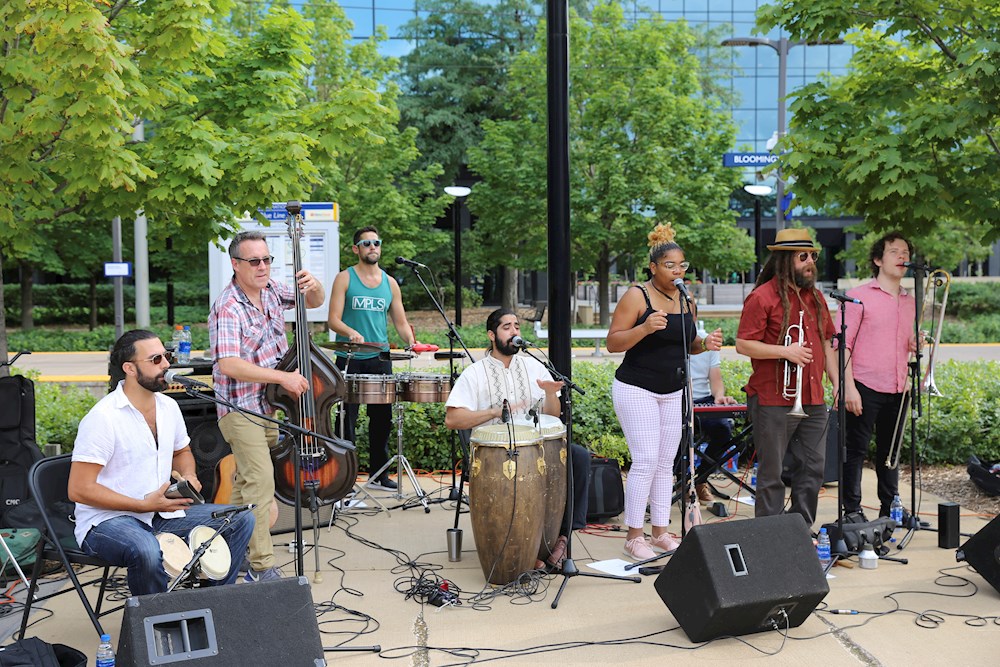- Sector Scan
Minneapolis Ranks Third in the Nation on Government Support for the Arts
- Posted Apr 13, 2023
3-minute read
Ranking third in the nation in Government Support for the arts, the Minneapolis-St. Paul-Bloomington metro area received more state and federal arts grants and dollars per capita than any other midwestern community in the 2022 Arts Vibrancy Index Report. Nationally, it falls in the top 1% for state arts dollars per capita, experiencing a large jump in program revenue – that is, revenue earned from participation in arts and culture, and receiving high rankings for total expenses per capita as well as total compensation paid to those working for arts and cultural organizations.

In the summer of 2020, a City of Minneapolis police officer murdered George Floyd. The killing and subsequent uprising showed in stark relief the ongoing trauma of institutional racism, and it required a direct response. The city of Minneapolis’ Office of Arts, Culture and the Creative Economy repurposed grant funding from Kresge to launch the Creative Response Fund, providing 10 artist projects with the income necessary to provide direct healing and support to impacted communities. Funding continues to be offered through 2022. Minneapolis’ Creative City Making program pairs artists, primarily from BIPOC communities, with city staff on various projects and initiatives that aim to address inequities. In 2021 this program generated income for 65 artists. A Kresge-funded evaluation recommends that this program “should be permanently integrated into how local government addresses racial equity.”
Economic justice has also been a focus of the local arts community over the last several years. In 2021, The City of Saint-Paul partnered with Springboard for the Arts to launch a pilot program providing a guaranteed minimum income for local artists and funding. The pilot provided $500 of unrestricted monthly support to 25 St. Paul artists for 18 months. “Springboard for the Arts is a vital partner in our work to ensure no one is left behind in this pandemic,” said Saint Paul Mayor Melvin Carter. The City of Saint Paul and Springboard also partnered on an ongoing narrative change project: Artists Respond: People, Place, and Prosperity. This growing cohort of artists have created public projects that demonstrate the root causes that lead to the need for guaranteed income, and the impact of guaranteed income on the families and communities that are supported by it.
The Minneapolis-St. Paul-Bloomington area has revered music, literary and publishing scenes, strong theaters, a great orchestra, a wealth of performance and dance troupes, public art, and many opportunities for visual artists in the region’s renowned advertising sector. The city is home to the Minnesota Fringe Festival, the largest non-juried performing arts festival in the U.S., and Art-A-Whirl, the largest open studio tour organized by the Northeast Minneapolis Arts Association. Among the large midwestern communities on this year’s list, Minneapolis ranks highest on the number of arts providers per capita.
Minneapolis is home to one of the largest concentrations of urban Native Americans in the U.S. For the last forty years, Franklin Avenue in south Minneapolis has been the heart of this community: a place where American Indians live, work, and access cultural-specific services. The American Indian Cultural Corridor aims to re-brand the traditional heart of the city's Native American community as a place where both Indians and tourists can enjoy Native American food, art, and culture on Franklin Avenue and in the Phillips Neighborhood of Minneapolis, Minnesota. Today, this presence is visible in the various American Indian institutions clustered on and around the avenue, including urban tribal offices, the American Indian Center, All My Relations Arts Gallery, Little Earth Housing Corporation, the American Indian Industrial Opportunities Center, and the Indian Health Board.
A first-tier suburb south of Minneapolis, Bloomington boasts its own impressive art scene; eight resident arts organizations are housed in the city’s Civic Plaza, including Artistry, a small professional theater and multidisciplinary art center, and creative placemaking partner with the city of Bloomington; Angelica Cantanti Youth Choirs, serving 400+ youth and performing across the state of Minnesota; Bloomington Symphony Orchestra, a 78-person orchestra; Medalist Band, a 70-musician, nationally reputable and award-winning concert band; and Continental Ballet Company, a professional dance company and school.
Thank you to Alejandra Pelinka of the City of Bloomington, Minnesota for their thoughtful contributions to the making of this article.
ABOUT THE ARTS VIBRANCY INDEX
The Arts Vibrancy Index examines the level of supply, demand, and government support of the arts in more than 900 communities across the country. Accompanied by an interactive Arts Vibrancy Map that reveals the arts-vibrancy score of every county in the U.S., the Index lists, in alphabetical order, the 20 most arts-vibrant large cities, the 10 most arts-vibrant medium cities, and the 10 most arts-vibrant small cities. In this year’s Index, the first since 2020, four communities debut on the lists, and an additional five return after an absence of at least three years.



Comments
Leave yours below.